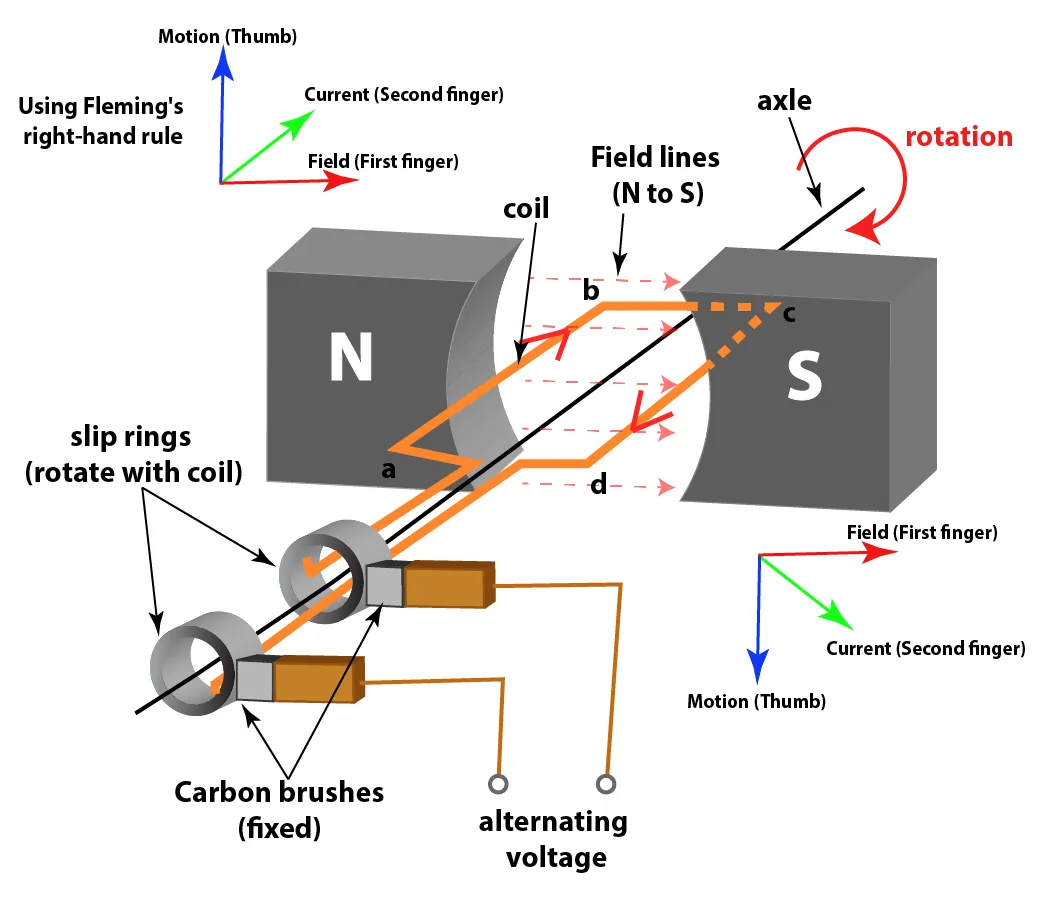4.5 Electromagnetic effects
4.5.2 The a.c. generator
Supplement Concepts
1. What is an A.C. Generator?
- An a.c. generator (alternating current generator) is a device that converts mechanical energy into electrical energy in the form of alternating current (a.c.).
- It works based on electromagnetic induction, discovered by Faraday.
- Alternating current means the current flows first in one direction, then reverses and flows in the opposite direction.
2. How Does It Work?
- The generator has a coil of wire that rotates inside a magnetic field.
- As the coil spins, it cuts through magnetic field lines, which induces a voltage (e.m.f.) in the coil.
- The coil is connected to the circuit using slip rings and brushes:
- Slip rings: Rotate with the coil and maintain contact with the brushes.
- Brushes: Stationary and allow the current to flow out of the generator.

Figure 1: Simple a.c generator
3. Graph of E.M.F. vs. Time
- The e.m.f. produced by the generator changes as the coil rotates.
- The graph of e.m.f. against time looks like a wave (sinusoidal):
- Peak: Maximum e.m.f. when the coil cuts the most magnetic field lines (horizontal position).
- Zero: No e.m.f. when the coil is vertical and not cutting field lines.
- Trough: Maximum e.m.f. in the opposite direction when the coil cuts field lines in the opposite direction.

Figure 2: Output from a simple a.c. generator
4. How to Increase the Voltage
You can increase the voltage (e.m.f.) generated by:
- Spinning the coil faster: More field lines are cut per second.
- Using a coil with more turns of wire: More wires cutting field lines.
- Using a coil with a larger area: More field lines are cut.
- Using stronger magnets: More field lines to cut.
5. Frequency of A.C.
- The frequency of the alternating current depends on how fast the coil spins.
- For example, if the coil spins 50 times per second, the frequency of the a.c. is 50 Hz.
Key Points to Remember:
- A.C. generators produce alternating current.
- Slip rings and brushes are used to transfer the current out of the generator.
- The e.m.f. graph is a wave that shows how the voltage changes as the coil rotates.
- Voltage can be increased by spinning the coil faster, using more turns of wire, a larger coil, or stronger magnets.
1. What is the purpose of slip rings in an a.c. generator?
Slip rings are used to transfer the alternating current (a.c.) from the rotating coil to the external circuit. They maintain continuous contact with the brushes, allowing the current to flow out of the generator without tangling the wires.
2. Sketch a graph of e.m.f. against time for an a.c. generator and label the peaks and troughs.
The graph is a wave (sinusoidal) that shows how the e.m.f. changes over time.
• Peaks: Represent the maximum e.m.f. (positive and negative).
• Troughs: Represent the minimum e.m.f. (negative peaks).
• Zero points: Occur when the coil is vertical and not cutting magnetic field lines.
• Peaks: Represent the maximum e.m.f. (positive and negative).
• Troughs: Represent the minimum e.m.f. (negative peaks).
• Zero points: Occur when the coil is vertical and not cutting magnetic field lines.
3. Name two ways to increase the voltage produced by an a.c. generator.
1. Spin the coil faster: This increases the rate at which magnetic field lines are cut.
2. Use stronger magnets: This increases the strength of the magnetic field, so more field lines are cut.
2. Use stronger magnets: This increases the strength of the magnetic field, so more field lines are cut.
4. What happens to the e.m.f. when the coil is vertical?
When the coil is vertical, it is not cutting any magnetic field lines, so the induced e.m.f. is zero. This corresponds to the zero points on the e.m.f. vs. time graph.
